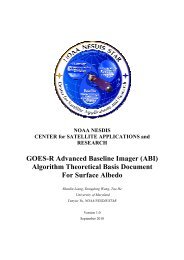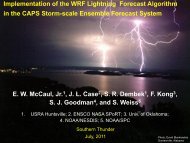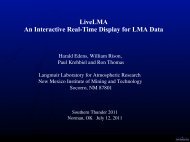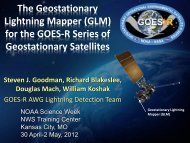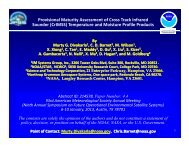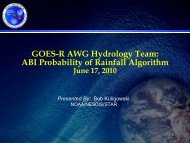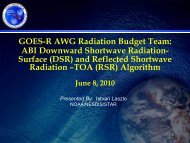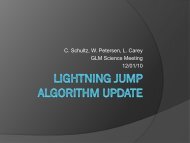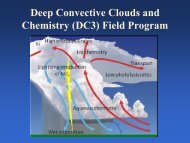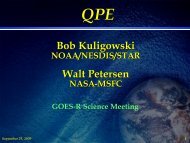GOES-R MANAGEMENT CONTROL PLAN (MCP)
GOES-R MANAGEMENT CONTROL PLAN (MCP)
GOES-R MANAGEMENT CONTROL PLAN (MCP)
Create successful ePaper yourself
Turn your PDF publications into a flip-book with our unique Google optimized e-Paper software.
APPENDIX D: <strong>GOES</strong> HISTORY<br />
Over the past four decades, environmental stewardship agencies have stated a need for near continuous,<br />
timely, high quality observations of the Earth and its environment. As an example, for rapidly changing<br />
severe storms (such as hurricanes and storms that produce flash floods, tornadoes or hail), frequent<br />
observations of weather phenomena that produce and guide such storms are essential to provide adequate<br />
tracking and warning.<br />
The successful development and operation of the spin scan cloud camera on ATS-1 and of a similar<br />
camera on ATS-3 (launched in 1967) led to the decision to proceed with an operational system for<br />
meteorology. NASA developed the new spacecraft system and built two prototypes, called Synchronous<br />
Meteorological Satellites, SMS-1 and SMS-2. They were launched in May 1974 and February 1975.<br />
Three identical versions funded by NOAA, <strong>GOES</strong>-1, -2, and -3, were launched in October 1975, June<br />
1977, and June 1978. The primary sensor on all five satellites was the Visible Infrared Spin Scan<br />
Radiometer (VISSR).<br />
<strong>GOES</strong>-4-7 introduced an improved VISSR, the VISSR Atmospheric Sounder (VAS), which gathered the<br />
standard VISSR image data and also took measurements of the atmosphere, enabling meteorologists to<br />
acquire temperature and moisture data profiles. <strong>GOES</strong>-7, launched in 1987, was the last spinner-type<br />
geosynchronous satellite. It inaugurated the use of geosynchronous satellites for international search and<br />
rescue efforts.<br />
Five satellites, <strong>GOES</strong>-I through <strong>GOES</strong>-M, were ordered in the <strong>GOES</strong>-I series. The design of the <strong>GOES</strong>-I<br />
series represented a major step forward from previous <strong>GOES</strong> satellites due to the use of separate imagers<br />
and sounders with much higher temporal and spatial resolution, more channels and more precise<br />
measurements. The <strong>GOES</strong> I-M satellites incorporate the use of a 3-axis stabilized spacecraft bus allowing<br />
continuous observations.<br />
Three additional satellites, <strong>GOES</strong>-N, -O, and -P (designated the <strong>GOES</strong>-N series), have been procured<br />
subsequent to the <strong>GOES</strong>-I series. While operating essentially the same set of instruments, the major<br />
difference between the <strong>GOES</strong>-I series and <strong>GOES</strong>-N series is in the area of navigation and the inclusion of<br />
the Solar X-Ray Imager on all satellites (versus only the <strong>GOES</strong>-M satellite on the previous series). The<br />
<strong>GOES</strong>-I series uses an earth reference system while <strong>GOES</strong>-N series employs a stellar inertial system.<br />
The <strong>GOES</strong>-R series of satellites is the newest generation of NOAA’s geosynchronous environmental<br />
satellites. The <strong>GOES</strong>-R series represents another major step in providing remotely sensed environmental<br />
data. In addition to temporal and spatial improvements, <strong>GOES</strong>-R instrumentation will provide significant<br />
advances in the quality and quantity of remotely sensed environmental data.<br />
<strong>GOES</strong>-R Series ERA<br />
Page 74 of 75




